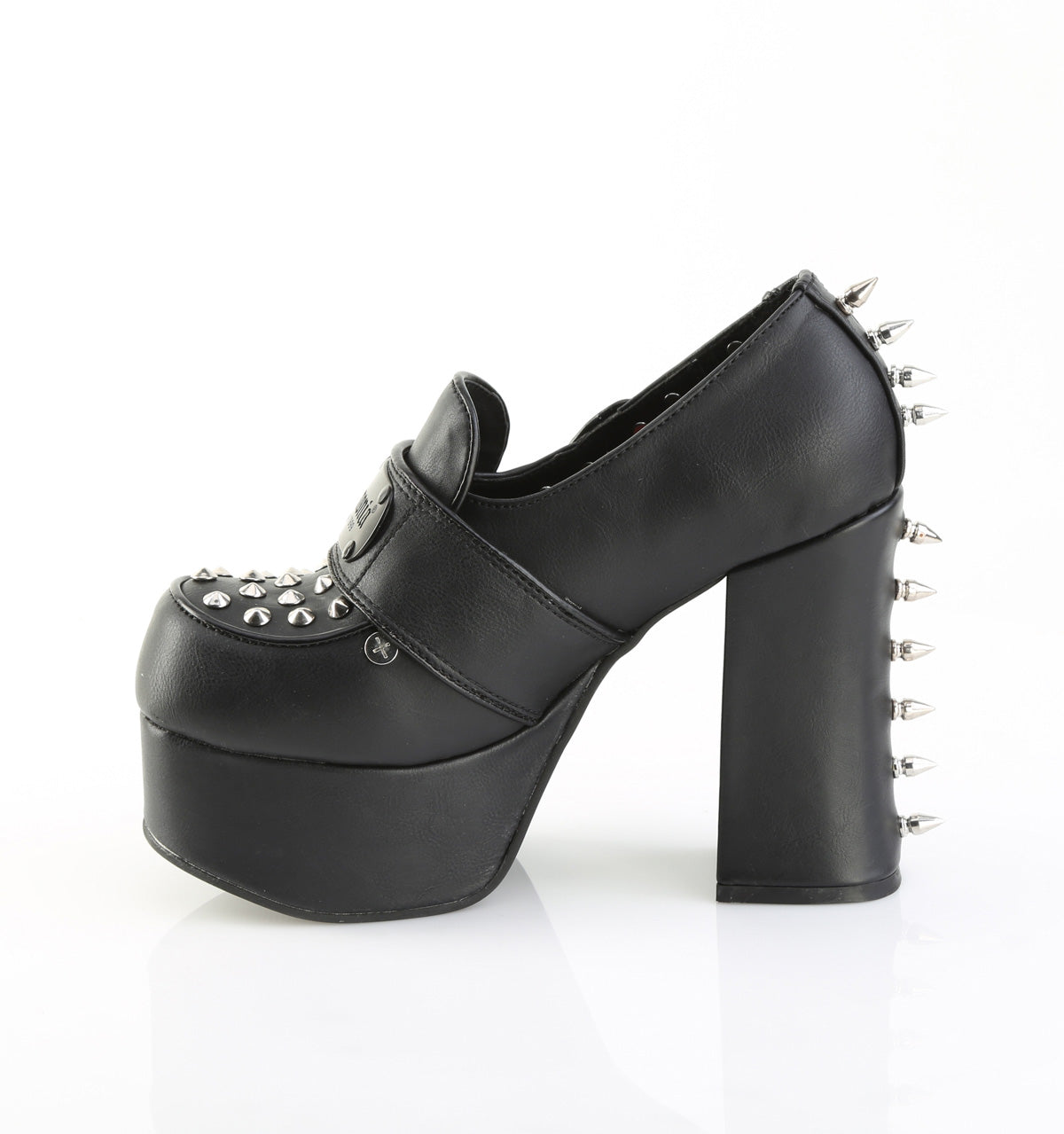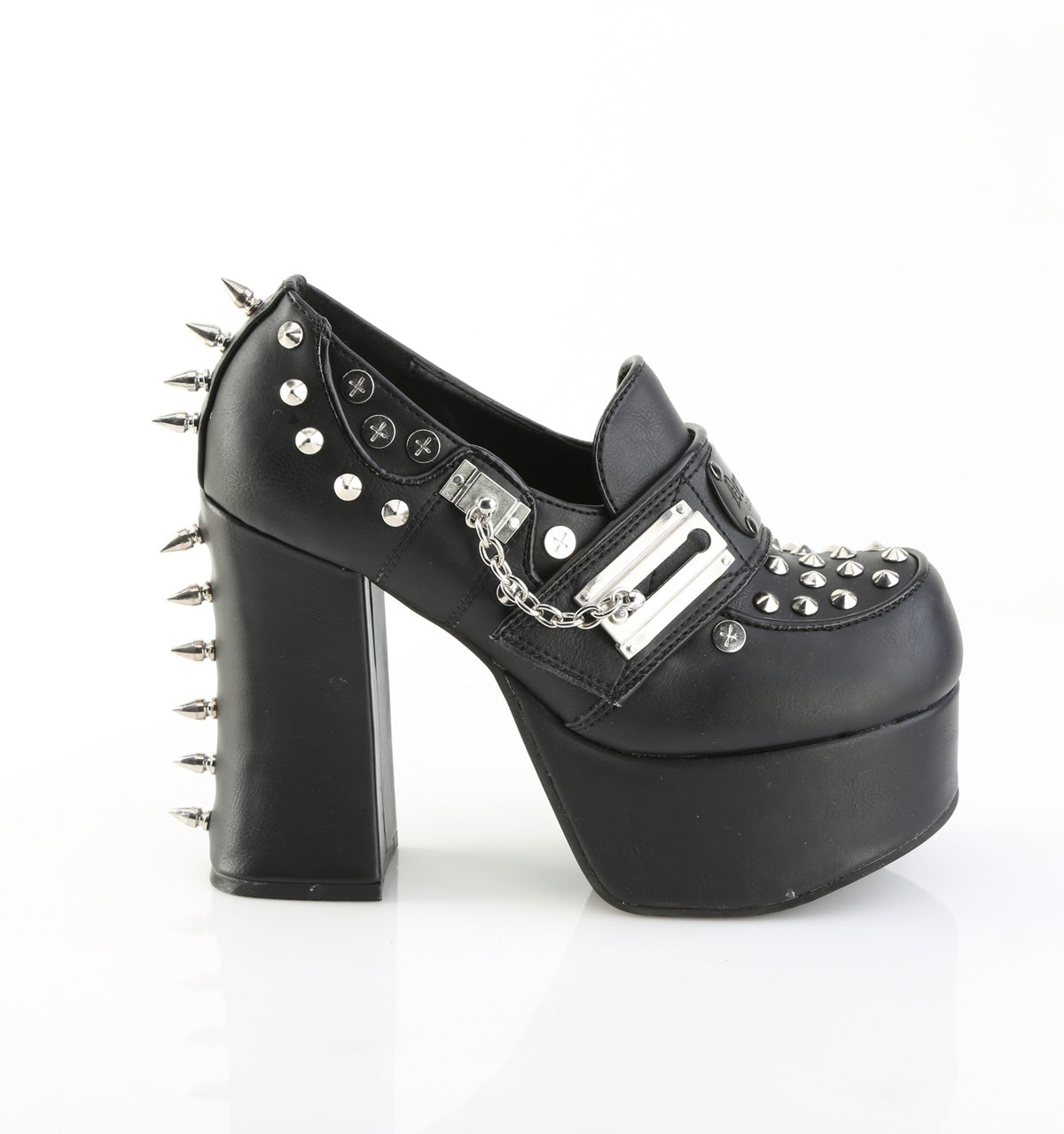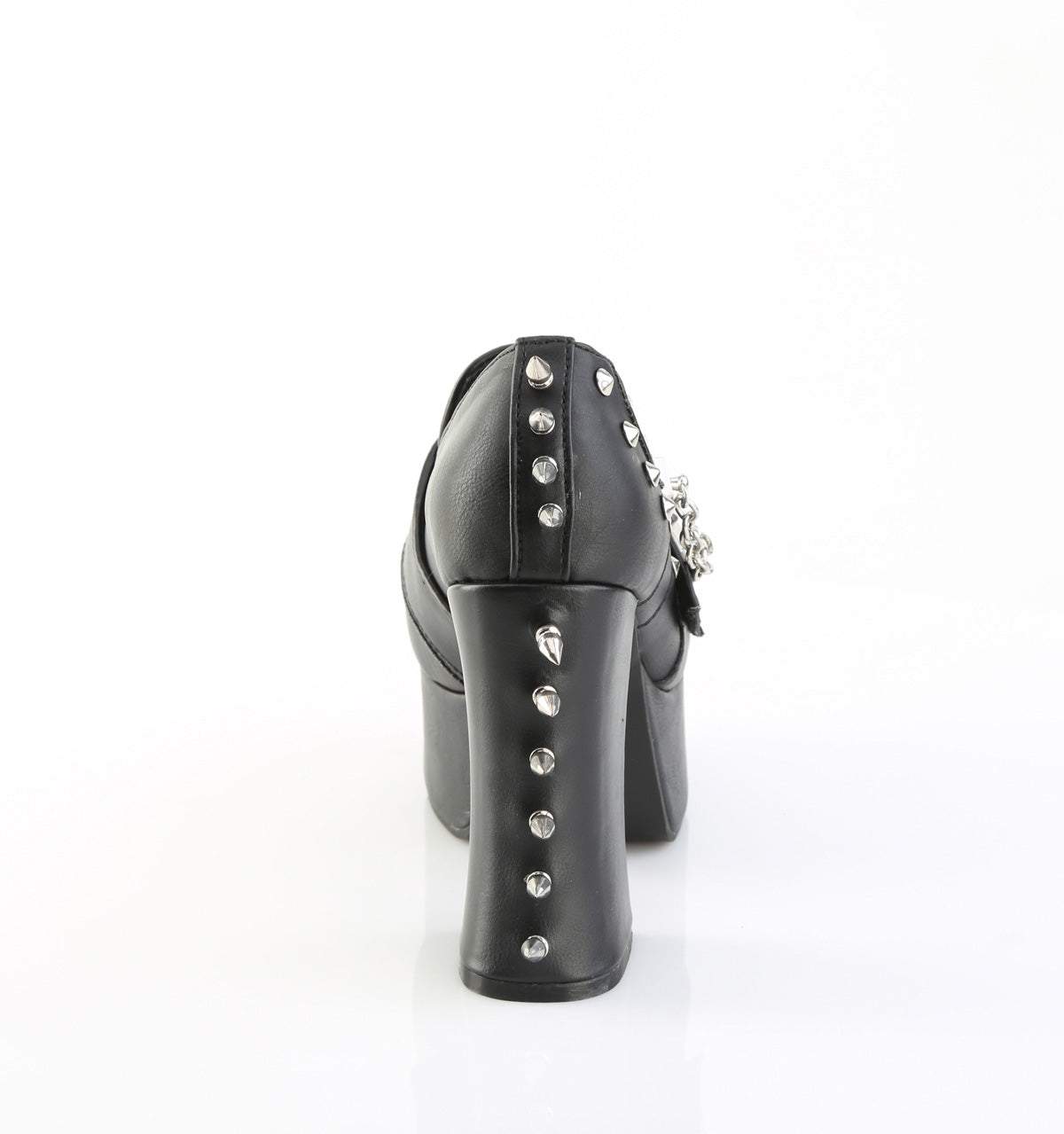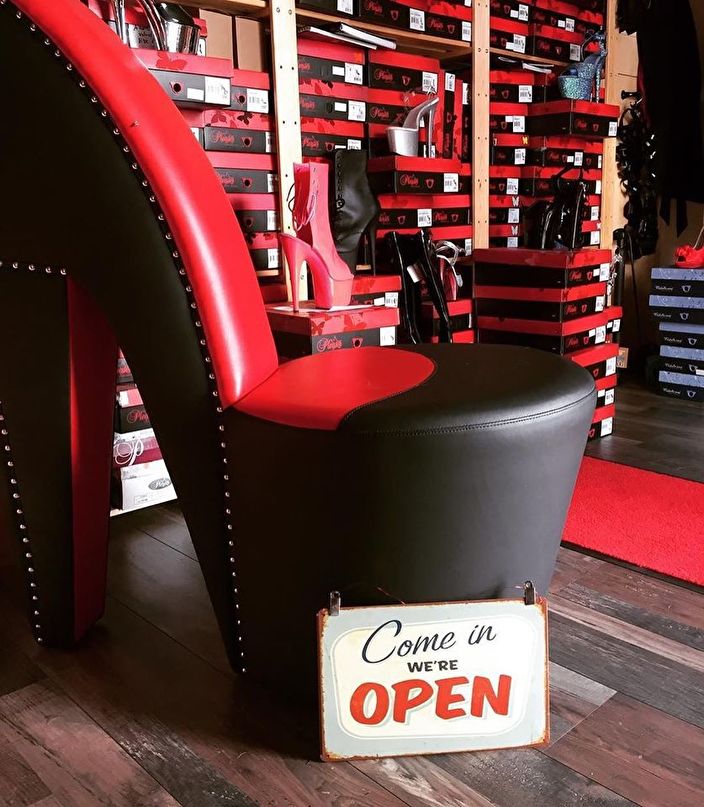ⓘ Part of the DemoniaCult-styles temporarily suspended
Part of the DemoniaCult collection is suspended for sale for an unknown period of time.
As soon as these styles are available again, you will be able to order them again.
If you want to be notified when a specific style in your size is available again you can click on the "EMAIL ME WHEN BACK IN STOCK" button and fill in your details, that way you will receive an email when you can order them again.

Temporarily suspended for sale
DemoniaCult Charade 32
DemoniaCult Charade 32
(Temporarily) Out of stock
Product Description:
Matzwarte plateau-loafer pumps met puntige- en ronde studs op de voorvoet en aan de achterzijde van de hiel, een klittenband-riempje met een sliding-lock met een ketting aan de buitenzijde en een 'Demonia'-branded metalen-plaat aan de voorzijde
Black Faux Leather Platform Loafer-Pumps with Spiked & Cone Studs on the Vamp & Up the Back of the Heel, Flat Screw Studs, a Hook-N-Loop Strap with Sliding Lock Chain & a Demonia Branded Metal Plate at the Front
Temporarily suspended for sale





DemoniaCult temporarily suspended
Part of the DemoniaCult collection is suspended for sale for an unknown period of time.
As soon as these styles are available again, you will be able to order them again.
If you want to be notified when a specific style in your size is available again you can click on the "EMAIL ME WHEN BACK IN STOCK" button and fill in your details, that way you will receive an email when you can order them again.

ⓘ Explanation of the specifications
Collapsible content
What is the heel height and platform height
📏 The heel height and platform height 📏
Here you will find a short explanation of the heel height and platform height ! Do you want to read the explanation of all shoe specifications? Then take a look at the following page:
💡 Tip: Click on the images to enlarge them!
Heel height and platform height:
For many people, these two factors are decisive in choosing their perfect pair of heels. Especially in the world of pole dancing, exotic dance and pole fitness, heel heights are often indicated in inches instead of centimeters.
To make it easy for you, I always give both sizes - in inches and in cm. That way you don't have to convert them yourself! 😉
How they are measured:
Heel height (abbreviated "HH") |
Platform height (abbreviated "PF") |
|
For Pleaser heels, the heel height is measured from the point where the heel touches the ground, in a straight line up to the point where the heel touches the sole. You can see this in the image below: |
The platform height is measured from the bottom of the outer sole; where it touches the ground, to the top of the platform; the height at which your foot rests. This is shown in the image below: |
What is the 'walking height'
📏 The walking height 📏
Here you will find a short explanation of the walking height! Do you want to read the explanation of all shoe specifications? Then take a look at the following page:
💡 Tip: Click on the images to enlarge them!
Walking height:
The walking height is the 'real' heel height you walk on. We calculate this with the next 'formula':
Heel height - Platform height = Walking height
- For heels without a platform, the heel height is the same as the walking height because nothing is subtracted from the heel height
- For heels with a platform, the 'real' heel height you walk on is less than the total heel height because your foot rests on a platform. That means the sole of the shoe has literally been raised and your foot is standing higher. You can therefore subtract the platform height from the heel height to calculate the walking height.
The following image shows an example:
What is the heel distance
📏 The heel distance 📏
Here you will find a short explanation of the heel distance! Do you want to read the explanation of all shoe specifications? Then take a look at the following page:
💡 Tip: Click on the images to enlarge them!
Heel distance
- A steeper heel has a shorter heel distance
(and a sharper slope angle* = a lower angle in degrees*) - The shorter the heel distance, the steeper the heels feel.
The shorter the heel distance, the higher the heels of the shoes feel/the steeper the shoes will be.
How this is measured
Measuring the heel distance is best done when comparing two different shoes of the same size and with the same walking or heel height.
You don't even have to measure the distance exactly if you can clearly see whether the distance of one shoe is shorter than the other*
💡Important:
- The shorter the heel distance, the higher/steeper the heels feel
*Where exactly you should measure this distance is sometimes difficult to say. In this more extensive explanation about the heel distance you can find more explanation about how and where you can measure this. But usually you do not need all this information to buy heels. |
|
The next image shows an example of how heel distance affects the 'steepness' of a shoe. The triangle represents the 'space between' the heel and the outsole/slope as seen in the heel on the left.
|
Don't compare apples with oranges:There is no point in comparing the heel distance of size 36 shoes with size 40 shoes; or comparing the heel distance of shoes with a platform to a shoe without a platform.Why?shoes in size 40 always have a longer heel distance than the same shoe in size 36 because size 40 is simply longer than size 36. The heel will therefore also have to be at a longer distance from the outsole than with size 36 in order to maintain the same 'steepness'.The same applies to shoes with a platform and shoes without a platform. If you compare shoes with the same heel height and heel distance, one of which has a platform and the other does not have a platform, you will stand less steeply on the shoe with a platform sole because the heel distance should actually be measured at the 'walking height' (see the information about Walking height) |
Summary:
If the heel distance is smaller (shorter), the slope is steeper and the slope angle is sharper (the degree of the angle is 'lower')
The heel of shoes with a shorter heel distance will therefore also feel higher
Let customers speak for us
from 131 reviewsBij kinky-shoes een groot aanbod, snelle levering, prettige communicatie en persoonlijke adviezen vanuit de verkoper, ik ben helemaal tevreden over mijn aankoop (pleasers) en kan het iedereen aanraden!

Order relatief snel (vanuit US) ontvangen, leuk ingepakt. De hakken zitten ook heerlijk, zal in de toekomst zeker nog eens bestellen.

Les chaussures sont arrivées rapidement et super bien emballées avec des jolies petites attentions ! Je suis vraiment contente d'être passée par cette boutique. Merci !

Amazing service thank you so much so happy 🩷🩷🩷

This is my first pair of Pleasers and I'm SO GLAD I bought them thru Kinky-Shoes! Arrived way earlier than I thought and they're intact, I'm in love with them and the service was impeccable 🩷 would definitely recommend.

So happy with my new shoes, the fit is perfect and they look so beautiful! Always a pleasure to order from Chiara, she always keeps me up to date with my order and leaves a sweet surprise in the package as well❤️ i’ll be a returning customer for a looong time to come!

Contact en updates over de bestelling is 100% top geweest netjes updates gehad over de levering en vertragingen zeer tevreden over de service

Schitterende.feestelijke kinky hakken. Van pleaser.
De.maatvoering is weer perfect.
![Pleaser Adore 3021GP [Maat 45 | US-14]](https://judgeme.imgix.net/kinky-shoes/1735840447__img_20250102_142005714__original.jpg?auto=format&w=70)
Alles is prima verlopen goede communicatie en vlotte kevering.De laarzen zijn TOP ! Héél comfortabel. Thanks.
![Funtasma Gogo 300X [Wide Calf | Wide Width!]](https://judgeme.imgix.net/kinky-shoes/1732517784__f14b5165-a7ef-4143-8061-7f3f71c74825-1_a__original.jpg?auto=format&w=70)
Zoals (in mijn ervaringen) altijd, opnieuw een goede schoen van Pleaser. Dat was niks nieuws voor mij. Wat wel nieuw is, is de ervaring met Kinky Shoes. En daarvan kan ik alleen maar zeggen dat dat een heel goede ervaring is. Snelle verwerking van de bestelling en goede feedback over de voortgang ervan. Deze winkel staat nu onder mijn favorieten opgeslagen.

Comfy and super cool! Didn’t have to break them in much, fits very comfortable, and look very flattering, the right length to accommodate knee pads also. Fast delivery as well!

KS was voor vragen zeer goed bereikbaar en de bestelling was vlot voltooid! De laars is fantastisch, veel grip op de paal maar glijd op de (laminaat) vloer… waar andere laarzen blijven plakken op de vloer. Precies wat je nodig hebt, super voor flows! Maat valt precies goed.

Pleaser Flamingo 1045VEL It’s my personal love😍 I enjoy my new shoes so much!
Buying a new shoes in kinky-shoes it was pleasure for me and they arrived perfectly in time (2-3days took delivery)

Prachtige rode muiltjes van Devious met een perfecte pasvorm en super sexy❤️❤️

Collapsible content
General information
I import most items especially for you upon your order from the supplier. The average delivery time is 1 to 1½ weeks (within the Netherlands) but this can also be longer. This is an average delivery time, therefore it's not a promise or guarantee! Please keep that in mind!**
Please note:
* When returning multiple items that have been imported, I will always calculate the costs incurred per individual situation; the amount that will be deducted and the amount that will be converted into shop credit depends on the actual costs incurred and are subject to a reasonable compensation for the losses incurred. More information about a reasonable compensation for the losses incurred can be found in this Dutch Law and can be read in this Dutch article here and here. This applies to: |
I would prefer not to have to charge these costs, but in order to cover the costs (losses) I have incurred due to the increasing number of returns, this has unfortunately proven necessary. To limit the number of returns (please think about the environment too) I would like to ask you to think just a little longer about your purchase, to make a well-considered decision and, if you are unsure, to ask me for advice or help!
For a single exchange for a different size, these costs will not be charged. You can read more about this in the Terms and Conditions and Refund Policy.
|
**Important Notice on Delivery Times During Peak Periods: Any delays resulting from these circumstances are beyond my control and do not qualify for compensation, order cancellation, or any other remedies. While I will make every effort to process and ship orders as quickly as possible, all stated delivery times are purely indicative. Thank you for your understanding. |
Contact
Email:
info@kinky-shoes.nl
Visiting address:
On appointment Only (Monday - Friday)!
Kinky-shoes
Thomas J. Witteroosstraat 18
6827 AZ ARNHEM (NL)
KvK 743 520 16 | BTW-id NL 002 366 589 B32

Sizing and Dimensions
Sizing for Sway polewear:
The sizing of Sway items are indicated in the product-specifications on a product page. For most Sway polewear you can find a minimum and maximum size measurement because they are adjustable. Please measure your body at the parts where the size of the polewear is measured to ensure you will buy the right size.
Pleaser shoes converted sizing:
Pleaser shoes come from the USA and have American sizing (1 inch = 2.54 cm). Pleaser lists both US sizes (American shoe sizes) and EU sizes (European shoe sizes) on the shoe boxes.
However, experience has shown that the listed, converted EU sizes are not always correct. In particular, the larger shoe sizes are often larger than stated on the shoe box. For this reason, I use my own converted EU size chart (see the Sizing page) and not the EU sizes stated on the boxes.
From US-size 12, the sizing for most shoes is slightly adjusted:
- US-12 -> EU size 42/43;
- US-13 -> EU size 44;
- US-14 -> EU size 45 and so on
Important:Order the size you normally wear, I already take into account whether certain shoes have a smaller or larger fit. If you have already done that too, please let me know (at the comments section in your shopping cart or by e-mail stating your order number) so that your order won't be imported two sizes too big or too small. |
What if I want to order a specific US size?
If you would like to order a specific US size because you know which Pleaser US size you have, this is of course possible. I always buy the US size that is indicated. For example, as shown in the image below, I buy US-16 if you buy size 47/48:
You can see in the image above that the sizing has been adjusted slightly from US size 12 and up. For example, US-12 is a European size 42/43; US-13 is a European size 44; US-14 is a European size 45 and so on. On the shoe box, US-13 size 43 is indicated, but this conversion is not correct. So don't panic if you see another EU-size on the shoebox! ;)
How do I calculate the right size for me?
See how to calculate your size using a conversion table on the information page: "How do I know what size I have, and which one to order?"
If you are between 2 sizes, I usually advise rounding up the size for a closed style such as a pump or boot with a closed toe. For an open shoe style such as a sandals, where the toes and/or heel are 'open', I advise rounding down the size.
Of course you can always ask me for advice about which size you need:
info@kinky-shoes.nl
Boot Circumference and Shaft Height:
The calf circumference, shaft circumference and shaft height of boots can be found in the table on a product page.
The specification table on a product page contains a lot of information about the shoes. The indicated dimensions in the upper part of the table depend on the selected size; so make sure you have selected the correct size to see the correct data.
The table will look similar to this: In the upper part you can find the calf circumference, shaft circumference and shaft height in centimeters:
Have you already taken into account how the size fits and ordered a different size than you normally wear?
Please let me know if you have already made a conversion yourself so that the ordered item is not imported two sizes too big or too small. This can be done in the comments section in your shopping cart:

Of course you are always welcome to ask me for advice about which size you need:
info@kinky-shoes.nl
I would kindly like to ask you not to order the same item in different sizes and then return the sizes that do not fit.Please contact me so that I can help you determine the correct size. If the shoes do not fit after all, you can always exchange them for a different size!It is a waste of time and money to order an item in multiple sizes if you know in advance that some of those items will be returned. The costs for the return shipment are for your own account and if items have been imported especially for you upon your order, the import/postage/customs costs will also be charged on to you. Please refer to section 6.2: Right of withdrawal in the Terms of Service |















